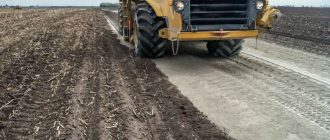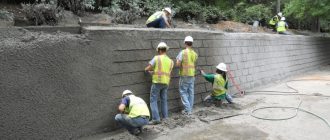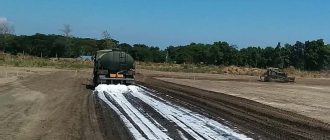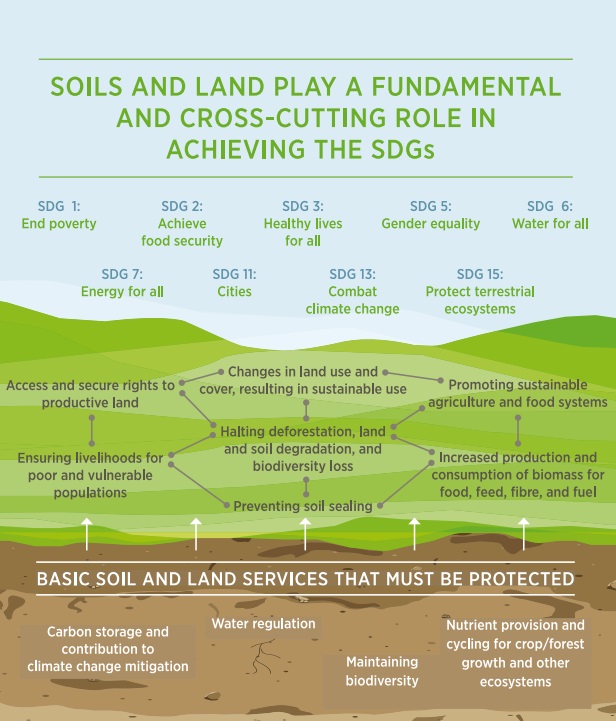
Exploring Soil Stabilization’s Contribution to Sustainable Land Management
Soil stabilization plays a crucial role in promoting sustainable land management practices. By exploring the benefits and techniques of soil stabilization, we can better understand its contribution to the long-term health and productivity of our land.
Soil stabilization refers to the process of improving the physical and chemical properties of soil to enhance its stability and performance. This technique is particularly important in areas with challenging terrain or high erosion rates. By utilizing various methods such as cement or lime stabilization, soil erosion can be minimized, preventing valuable topsoil from being washed away.
The contribution of soil stabilization to sustainable land management is multifaceted. Firstly, it helps to preserve the soil’s fertility by preventing erosion and retaining important nutrients. This leads to improved agricultural productivity and food security, as fertile soil is essential for successful crop growth. Additionally, stabilized soil provides a stable foundation for infrastructure projects, reducing the risk of damage and ensuring their long-term durability.
Furthermore, soil stabilization can contribute to environmental sustainability. By reducing erosion and runoff, it helps to protect nearby water bodies from sedimentation and pollution, preserving aquatic ecosystems. It also promotes the responsible use of land resources, as soil erosion can lead to decreased land productivity and increased desertification, which has devastating consequences for both the environment and local communities.
Exploring the various techniques and benefits of soil stabilization is key to implementing sustainable land management practices. By understanding the importance of preserving our soil’s health and stability, we can work towards a more resilient and sustainable future.
What is Soil Stabilization and Its Role in Sustainable Land Management?
Soil stabilization is a technique that aims to improve the physical properties of soil in order to make it more suitable for construction and other engineering activities. It involves the addition of various materials to the soil to enhance its strength, stability, and durability.
Sustainable land management refers to the practice of using land resources in a way that supports long-term ecological balance and meets the needs of present and future generations. It focuses on conserving soil, water, and biodiversity while also promoting economic and social well-being.
Soil stabilization’s role in sustainable land management is significant. By improving the properties of soil, it allows for the construction of more durable infrastructure that can withstand natural disasters and extreme weather events. This leads to a reduction in repair and maintenance costs and minimizes the impact on the environment.
Furthermore, exploring soil stabilization techniques and their application in sustainable land management can help mitigate soil erosion, which is a major environmental concern. Stabilizing soil prevents erosion by binding the particles together, reducing the risk of sediment runoff into water bodies and the loss of valuable topsoil.
Soil stabilization also plays a crucial role in enhancing soil fertility. By optimizing the physical properties of soil, such as its permeability and water-holding capacity, it creates a favorable environment for plant growth. This can lead to increased agricultural productivity and food security, supporting the overall goal of sustainable land management.
In summary, soil stabilization is an essential technique in sustainable land management. It contributes to the construction of durable infrastructure, helps mitigate soil erosion, and enhances soil fertility. By adopting soil stabilization practices, we can ensure the long-term health and productivity of our land resources while also promoting economic development and environmental conservation.
The Importance of Soil Stability in Environmental Planning
Exploring soil stabilization’s contribution to sustainable land management is crucial in environmental planning. One key aspect of sustainable land management is understanding the importance of soil stability.
Soil stability plays a crucial role in environmental planning as it affects the overall health and productivity of land. Stable soil provides a strong foundation for plants to grow and thrive, allowing for healthy ecosystems to develop.
By exploring different soil stabilization techniques, we can ensure that land is managed in a sustainable way. These techniques help prevent erosion, reduce soil degradation, and improve water quality. Ultimately, this contributes to the overall sustainability of the land and the health of the surrounding environment.
Stabilizing soil also aids in controlling sediment runoff, which can have detrimental effects on nearby water bodies. By implementing soil stabilization measures, such as vegetative cover or erosion control structures, we can prevent sediment from entering rivers, lakes, and other bodies of water, protecting aquatic ecosystems.
In addition to environmental benefits, ensuring soil stability in land management also has economic implications. Stable soil reduces the need for expensive maintenance and repairs, as well as the costs associated with erosion control and sediment cleanup.
With the increasing focus on sustainable land management practices, understanding the importance of soil stability is crucial for environmental planning. By exploring various soil stabilization methods and implementing them in land management strategies, we can contribute to the overall sustainability and health of our land and environment.
The Benefits of Soil Stabilization in Construction Projects
Soil stabilization plays a crucial role in the successful management of land during construction projects. By exploring soil stabilization’s contribution to sustainable land management, construction professionals can understand the importance of implementing effective soil stabilization techniques.
One of the primary benefits of soil stabilization is its ability to improve the strength and durability of the soil. By treating the soil with stabilizing agents, such as cement or lime, the engineering properties of the soil can be enhanced. This leads to increased load-bearing capacity, reducing the risk of soil settlement and other structural issues.
In addition to improving soil strength, stabilization can also mitigate erosion and control dust. By stabilizing the soil, it becomes more resistant to erosion caused by wind and water. This is especially important in construction projects where the exposed soil is vulnerable to erosion. Stabilization also helps control dust, which can be a significant concern in construction sites and adjacent areas.
Another benefit of soil stabilization is its cost-effectiveness. By stabilizing the existing soil instead of importing new materials, construction projects can save both time and money. The use of local soil resources reduces the need for transportation and disposal costs associated with importing materials. This makes soil stabilization an environmentally friendly choice that can contribute to sustainable construction practices.
Moreover, soil stabilization allows for greater flexibility in design and construction. By improving the soil’s engineering properties, construction professionals can design and build structures with confidence, knowing that the soil can withstand the required loads. This opens up opportunities for more innovative designs and construction techniques, ultimately leading to improved project outcomes.
In conclusion, soil stabilization offers numerous benefits that contribute to the success and sustainability of construction projects. Through enhanced soil strength, erosion mitigation, cost-effectiveness, and greater design flexibility, soil stabilization plays a crucial role in ensuring the long-term stability and durability of constructed facilities.
Methods of Soil Stabilization for Long-Term Land Management
Exploring soil stabilization’s contribution to sustainable land management requires an understanding of the various methods available for stabilizing soil in the long term.
Soil stabilization refers to the process of improving the physical properties of soil to enhance its stability, durability, and load-bearing capacity. This is especially important for land management practices aimed at promoting sustainability and minimizing environmental degradation.
| Cement Stabilization | This method involves mixing cement with soil to improve its strength and stability. Cement stabilization is commonly used in road construction and the construction of foundations for buildings and other structures. |
| Lime Stabilization | Lime stabilization involves adding lime, typically in the form of quicklime or hydrated lime, to soil to improve its plasticity, workability, and strength. Lime stabilization is often used in the construction of embankments and slopes. |
| Bitumen Stabilization | Bitumen stabilization involves mixing bitumen, a viscous black liquid, with soil to enhance its strength and resilience. This method is commonly used in road construction and the stabilization of parking areas. |
| Chemical Stabilization | Chemical stabilization involves the use of chemicals, such as polymers and soil conditioners, to improve the physical and mechanical properties of soil. This method is often used in construction projects where traditional stabilizers may not be feasible. |
| Geosynthetic Stabilization | Geosynthetic stabilization involves the use of geosynthetic materials, such as geotextiles and geogrids, to reinforce and stabilize soil. This method is commonly used in erosion control, slope stabilization, and landfill construction. |
| Mechanical Stabilization | Mechanical stabilization involves the use of mechanical means, such as compaction and reinforcement, to improve the strength and stability of soil. This method is often used in foundation construction and the stabilization of slopes. |
These methods of soil stabilization play a crucial role in long-term land management by ensuring the sustainability and resilience of soil in various applications. By improving soil stability, these methods contribute to the overall sustainability and environmental performance of land management practices.
Understanding the Chemical Composition of Stabilized Soil
In exploring the contribution of soil stabilization to sustainable land management, it is essential to understand the chemical composition of stabilized soil. This knowledge allows us to make informed decisions about the most effective and environmentally friendly methods of soil stabilization.
The chemical composition of soil refers to the elements and compounds present in the soil matrix. These elements and compounds play a crucial role in determining the soil’s physical and chemical properties, which in turn influence its stability and fertility.
Stabilized soil is a modified form of soil that has undergone a stabilization process to improve its engineering properties. This process typically involves adding stabilizing agents to the soil, such as cement, lime, or fly ash, which react chemically with the soil particles to enhance its stability.
When stabilizing agents are added to the soil, they undergo various chemical reactions with the soil particles. For example, in the case of cement stabilization, the cement reacts with water in a process called hydration, forming chemical compounds that bind the soil particles together.
The chemical composition of stabilized soil is influenced by several factors, including the type and amount of stabilizing agent used, the soil’s natural composition, and the environmental conditions during stabilization. These factors can affect the formation of new chemical compounds and alter the soil’s overall composition.
Understanding the chemical composition of stabilized soil is essential for assessing its long-term stability and environmental impact. It allows us to determine the extent to which the stabilization process has transformed the soil and evaluate its potential for sustainable land management.
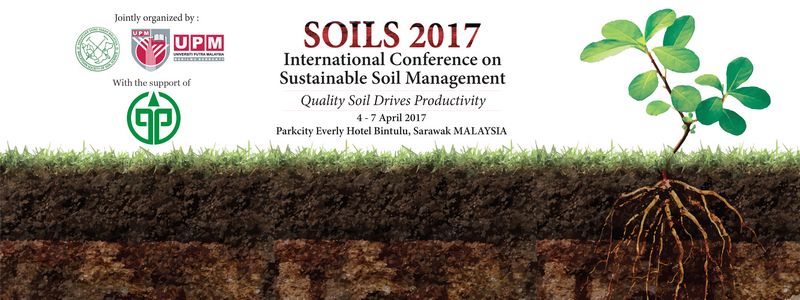
To gain a comprehensive understanding of the chemical composition of stabilized soil, laboratory analysis is often conducted. This analysis involves extracting soil samples from the stabilized area and subjecting them to various tests and experiments to determine the presence and concentration of different chemical elements and compounds.
A crucial aspect of analyzing the chemical composition of stabilized soil is determining the proportion and distribution of the stabilizing agent within the soil matrix. This information helps evaluate the effectiveness of the stabilization process and predict the soil’s behavior under different conditions.
In conclusion, understanding the chemical composition of stabilized soil is vital for exploring its contribution to sustainable land management. It provides insights into the reactions and transformations that occur during the soil stabilization process and enables us to make informed decisions regarding soil stabilization methods.
Examining the Mechanical Properties of Stabilized Soil
In the field of soil stabilization, understanding the mechanical properties of stabilized soil is crucial in ensuring sustainable land management. By exploring the contribution of stabilization’s mechanical properties to overall land management, we can effectively assess and implement soil stabilization techniques.
One of the main aims of soil stabilization is to enhance the mechanical properties of soil, making it more suitable for construction purposes. Through the use of various stabilization techniques, such as cement stabilization, lime stabilization, and bitumen stabilization, the engineering properties of soil can be improved.
Stabilized soil generally exhibits improved strength, durability, and load-bearing capacity compared to untreated soil. This makes it a viable solution for various construction projects, such as road construction, building foundations, and embankment construction.
The mechanical properties of stabilized soil can be analyzed through laboratory testing. Common tests include the compaction test, shear strength test, and unconfined compression test. These tests provide valuable data on the soil’s ability to withstand applied loads, its resistance to deformation, and its overall stability.
By examining the mechanical properties of stabilized soil, engineers and land managers can make informed decisions regarding the design and implementation of sustainable land management practices. The data obtained from these tests can help determine the optimal stabilization technique to be used, as well as the appropriate proportions and additives to be incorporated into the soil.
Additionally, understanding the mechanical properties of stabilized soil is essential in evaluating the long-term performance and durability of stabilization solutions. By assessing factors such as moisture content, compaction energy, and curing time, engineers can ensure that the stabilized soil will maintain its desired properties over time.
| Compaction Test | Measures the maximum dry density and optimum moisture content of the soil. |
| Shear Strength Test | Determines the soil’s resistance to shear forces. |
| Unconfined Compression Test | Measures the soil’s compressive strength. |
In conclusion, examining the mechanical properties of stabilized soil plays a vital role in understanding the contribution of soil stabilization techniques to sustainable land management. By utilizing laboratory testing and analyzing the results, engineers and land managers can ensure the successful implementation of stabilization solutions that meet the desired mechanical requirements.
Exploring the Role of Soil Stabilization in Erosion Control
Soil stabilization’s contribution to sustainable land management is well-documented and widely recognized. One crucial aspect of soil stabilization’s impact on land is its role in erosion control.
Erosion can pose significant challenges to land management, leading to the loss of topsoil, decreased soil fertility, and reduced land productivity. Soil stabilization techniques offer effective solutions to combat erosion and protect the land.
Soil stabilization involves using various methods and materials to enhance the physical and chemical properties of soil, making it more resistant to erosion. These techniques aim to improve the stability and cohesion of soil particles and prevent their movement during erosive events.
One commonly used method of soil stabilization for erosion control is the application of stabilizers such as polymers or chemicals. These substances can bind soil particles together, forming a robust soil structure that withstands the forces of water and wind erosion.
In addition to chemical stabilizers, physical methods like slope stabilization and terracing can also be employed to prevent erosion. By strategically shaping the land with slopes and terraces, soil movement can be minimized, and runoff can be controlled.
The role of soil stabilization in erosion control extends beyond managing surface erosion. It also plays a vital role in controlling subsurface erosion, such as soil piping and tunneling. By stabilizing the soil, these underground erosive processes can be mitigated, preventing potential damage to structures and infrastructure.
Exploring the role of soil stabilization in erosion control is essential for sustainable land management. By implementing effective soil stabilization techniques, land managers can mitigate erosion, protect the fertility of the soil, and promote long-term land productivity.
The Role of Soil Stabilization in Creating Resilient Infrastructure
Exploring the contribution of soil stabilization to sustainable land management is crucial for the development and maintenance of resilient infrastructure. Soil stabilization plays a key role in ensuring that infrastructure remains in optimum condition and can withstand the challenges posed by natural processes and human activities.
Soil stabilization involves the use of various techniques and materials to improve the physical properties of soil, making it more resistant to erosion, compaction, and other forms of degradation. By stabilizing the soil, we can create a solid foundation for infrastructure projects such as roads, highways, and buildings, ensuring their longevity and performance even under extreme conditions.
One important aspect of soil stabilization is its ability to mitigate the effects of climate change. As global temperatures rise, extreme weather events become more frequent, posing a significant threat to infrastructure. By stabilizing the soil, we can enhance its resilience to erosion caused by heavy rainfall and prevent the formation of sinkholes due to groundwater fluctuations.
Furthermore, soil stabilization can also contribute to sustainable land management by reducing the need for excessive excavation and replacement of soil. By using stabilization techniques, we can optimize the existing soil resources and minimize the environmental impact of construction projects.
In conclusion, exploring the contribution of soil stabilization to sustainable land management is essential for creating resilient infrastructure. By implementing soil stabilization techniques, we can enhance the durability and longevity of infrastructure, mitigate the effects of climate change, and promote sustainable land use practices. Investing in soil stabilization is a key step towards building a more resilient and sustainable future.
How Soil Stabilization Contributes to Sustainable Agriculture
Exploring soil stabilization’s contribution to sustainable land management is crucial in understanding how it supports sustainable agriculture. Soil stabilization serves as a key management practice that aims to improve the physical, chemical, and biological properties of soil to enhance its fertility and productivity.
Sustainable agriculture, on the other hand, focuses on cultivating and managing land in a way that preserves and enhances the long-term health of the ecosystem. By employing soil stabilization techniques, farmers can effectively prevent soil erosion, improve water infiltration, and enhance nutrient retention, all of which are essential for sustainable agricultural practices.
Soil stabilization plays a significant role in sustainable agriculture through several key contributions:
1. Preventing soil erosion: Implementing soil stabilization techniques such as contour plowing or terracing helps to slow down the movement of water across sloped land, preventing soil erosion. This is crucial for maintaining soil fertility and preventing valuable topsoil from being lost.
2. Improving water infiltration: Soil stabilization methods like adding organic matter or applying mulch help to improve soil structure, allowing for better water infiltration and reducing runoff. This increased water infiltration ensures adequate moisture for crop growth, reducing the need for excessive irrigation.
3. Enhancing nutrient retention: By stabilizing soil through techniques like adding organic amendments or using cover crops, farmers can increase the soil’s ability to retain essential nutrients. This reduces the need for synthetic fertilizers, minimizing the environmental impacts associated with their use.
4. Reducing greenhouse gas emissions: Proper soil stabilization practices can help sequester carbon in the soil, reducing greenhouse gas emissions. Carbon sequestration improves soil health and fertility while mitigating climate change.
5. Promoting biodiversity: Sustainable agriculture aims to promote biodiversity in and around cultivated areas. Soil stabilization techniques help create a favorable environment for beneficial soil organisms, such as earthworms and beneficial bacteria, which contribute to healthy soil ecosystems.
In conclusion, soil stabilization contributes significantly to sustainable agriculture by preventing soil erosion, improving water infiltration, enhancing nutrient retention, reducing greenhouse gas emissions, and promoting biodiversity. Incorporating soil stabilization practices into land management strategies is vital for ensuring long-term agricultural productivity and ecological health.
Frequently asked questions:
What is soil stabilization and how does it contribute to sustainable land management?
Soil stabilization refers to the process of strengthening and improving the properties of soil to enhance its stability and durability. This technique plays a crucial role in sustainable land management by preventing soil erosion, reducing sedimentation, enhancing soil fertility, and improving the overall quality of the land.
What are the common methods used for soil stabilization?
There are several commonly used methods for soil stabilization, including the addition of stabilizing agents like lime, cement, or fly ash, mechanical methods such as compaction and grouting, and biological techniques like the use of vegetation or bio-enzymes. The choice of method depends on the specific characteristics of the soil and the desired outcomes.
Can soil stabilization be used in both urban and rural areas?
Yes, soil stabilization can be applied in both urban and rural areas. In urban areas, it is used for the construction of roads, buildings, and infrastructure to ensure their longevity and stability. In rural areas, soil stabilization techniques are often used in agricultural practices to prevent soil erosion and enhance crop productivity.
Is soil stabilization a cost-effective solution for land management?
Yes, soil stabilization is generally considered a cost-effective solution for land management. By preventing soil erosion and improving soil quality, it reduces the need for costly remediation measures in the future. Additionally, it increases the lifespan of infrastructure and reduces maintenance costs, making it a sustainable and economical option.
What are the environmental benefits of soil stabilization?
Soil stabilization offers several environmental benefits. It helps to mitigate soil erosion, which reduces sedimentation in water bodies and improves water quality. By enhancing soil fertility, it contributes to healthier vegetation and biodiversity. Overall, soil stabilization techniques promote sustainable land use and support the conservation of natural resources.
How does soil stabilization contribute to sustainable land management?
Soil stabilization plays a crucial role in sustainable land management by preventing soil erosion, improving soil structure, and reducing the risk of landslides. Through various techniques such as adding stabilizing agents or reinforcing with geosynthetics, soil stabilization helps to maintain soil integrity and fertility, making it suitable for long-term agricultural use.
What are the benefits of using soil stabilization techniques?
There are several benefits of using soil stabilization techniques. Firstly, it helps in reducing soil erosion, which can lead to loss of topsoil and nutrient depletion. Secondly, it improves soil structure by increasing its load-bearing capacity and resistance to compaction. Additionally, soil stabilization can effectively remediate areas prone to landslides, making them safer for habitation and development. Overall, these techniques contribute to sustainable land management by promoting the long-term health and productivity of soil.


